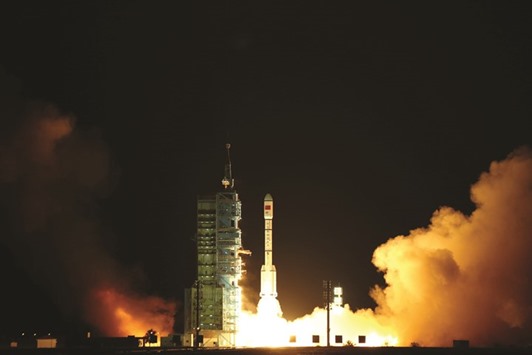China launched its second experimental space laboratory on Thursday, part of a broader plan to have a permanent manned space station in service around 2022.
Advancing China’s space programme is a priority for Beijing, with President Xi Jinping calling for the country to establish itself as a space power, and apart from its civilian ambitions, Beijing has tested anti-satellite missiles.
China insists its space programme is for peaceful purposes, but the US Defence Department has highlighted its increasing space capabilities, saying it was pursuing activities aimed to prevent adversaries from using space-based assets in a crisis.
In a manned space mission in 2013, three Chinese astronauts spent 15 days in orbit and docked with an experimental space laboratory, the Tiangong 1, or “Heavenly Palace”.
Its successor, Tiangong 2, lifted off on a Long March rocket just after 10pm (1400 GMT) from the remote launch site in Jiuquan, in the Gobi desert, in images carried live on state television.
The Shenzhou 11 spacecraft, which will carry two astronauts and dock with Tiangong 2, will be launched next month.
The astronauts expect to remain in Tiangong 2 for about a month, testing systems and processes for mid-term stays in space and refuelling, and conduct medical and other experiments.
The smooth launch imparts a high-tech sheen to week-long celebrations of China’s National Day, starting on October 1, as well as this week’s shorter Mid-Autumn Festival holiday that coincides with the full moon.
China would start building its space station as early as next year, Xinhua quoted Zhou Jianping, chief engineer of the manned spaceflight programme, as saying.
The station would be more economically efficient than the International Space Station and use “more data”, he said.
“Once the lab mission comes to an end, China will start building our own space station,” Zhou was quoted as saying.
Astronauts could be stationed in orbit for missions that last for more than one year in the facility, which has an initial designed life of at least 10 years, he said.
The longest single stay in space by a human so far is 437 days by Russian cosmonaut Valeri Polyakov.
China will launch a “core module” for the station some time around 2018, a senior official had said in April, part of a plan for a permanent manned space station in service around 2022.
The Chinese space station will weigh over 60 tonnes – much smaller than the 420-tonne International Space Station – and consist of a core module attached to two space labs, Xinhua said.
It will normally accommodate three astronauts at a time but has a maximum capacity of six, it added.
China has been working to develop its space programme for military, commercial and scientific purposes, but is still playing catch-up to established space powers the United States and Russia.
China’s Jade Rabbit moon rover landed on the moon in late 2013 to great national fanfare, but soon suffered severe technical difficulties.
The rover and the Chang’e 3 probe that carried it there were the first “soft landing” on the moon since 1976.
Both the United States and the Soviet Union had accomplished the feat earlier.

Tiangong-2 lifts off from the launch pad in Jiuquan, Gansu province, China, on Thursday.


